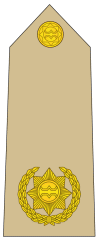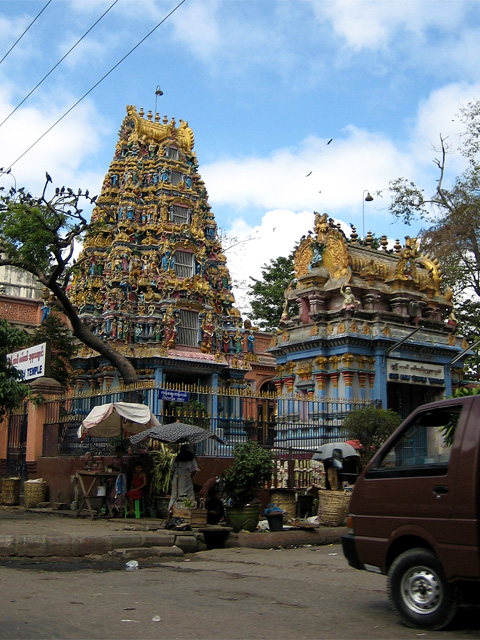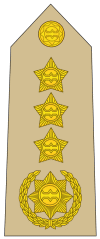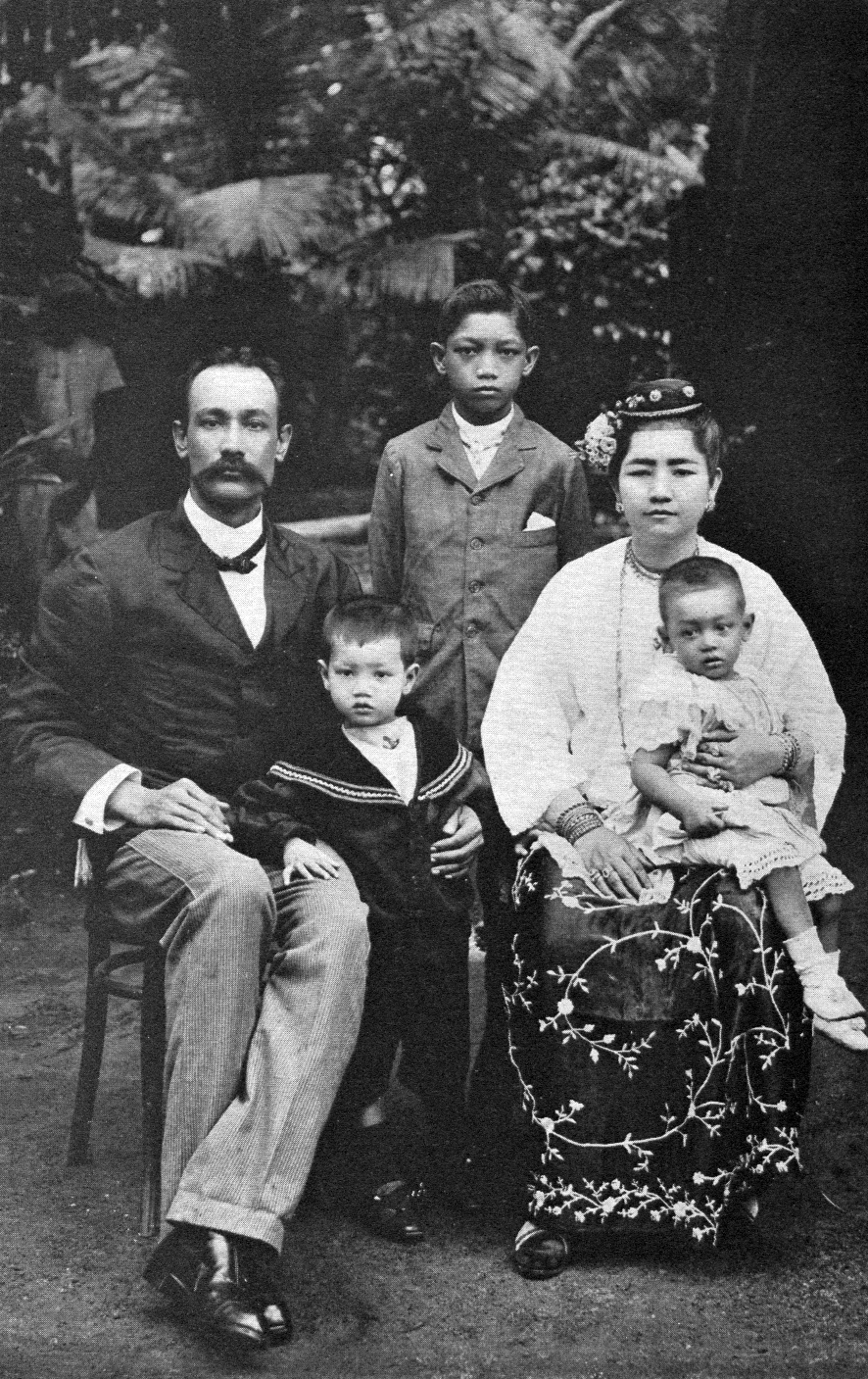|
David Abel (general)
David Oliver Abel ( my, ဒေးဗစ် အေဘယ်လ်; 28 February 1935 – 18 January 2019) was a Burmese economist, retired Brigadier General in the Myanmar Army and former cabinet minister. He served variously as Minister of Commerce, Minister of Finance and Revenue, and Minister of National Planning and Economic Development. At one time, he ran all three ministries simultaneously. He was considered the country's economic czar throughout the 1990s. Abel retired from the State Peace and Development Council and vacated his position as the Minister of the Chairman's Office on 25 August 2003. Early life and education Abel was born in 1935 in Insein, near Rangoon, but his family's roots were in Maymyo (now Pyin Oo Lwin). Abel's father, Alfred T. Abel was a Burma Railways engineer, while his mother Daw Chai, was a senior school teacher. Abel's father is an ethnic Indian Catholic, but he does have some Jewish ancestry. He is a Roman Catholic of mixed Anglo-Burman and ... [...More Info...] [...Related Items...] OR: [Wikipedia] [Google] [Baidu] |
State Peace And Development Council
The State Peace and Development Council ( my, နိုင်ငံတော် အေးချမ်းသာယာရေး နှင့် ဖွံ့ဖြိုးရေး ကောင်စီ ; abbreviated SPDC or , ) was the official name of the military government of Burma (Myanmar) which, in 1997, succeeded the State Law and Order Restoration Council ( my, နိုင်ငံတော်ငြိမ်ဝပ်ပိပြားမှုတည်ဆောက်ရေးအဖွဲ့ that seized power under the rule of Saw Maung in 1988. On 30 March 2011, Senior General and Council Chairman Than Shwe signed a decree that officially dissolved the council. From 1988 to 1997, the junta was known as the State Law and Order Restoration Council ( my, နိုင်ငံတော် ငြိမ်ဝပ်ပိပြားမှု တည်ဆောက်ရေးအဖွဲ့, links=no; abbreviated SLORC or ), which had succeeded the Pyithu Hluttaw as a leg ... [...More Info...] [...Related Items...] OR: [Wikipedia] [Google] [Baidu] |
Burmese Indians
Burmese Indians are a group of people of Indian origin who live in Myanmar (Burma). The term 'Burmese Indian' refers to a broad range of people from South Asia, most notably from present-day countries such as India, Bangladesh and also Pakistan. While Indians have lived in Burma for many centuries, most of the ancestors of the current Burmese Indian community emigrated to Burma from the start of British rule in the mid-19th century to the separation of British Burma from British India in 1937. During colonial times, ethnic Indians formed the backbone of the government and economy serving as soldiers, civil servants, merchants, moneylenders, mobile laborers and dock workers. A series of anti-Indian riots in the 1930s and mass emigration at the onset of the Japanese invasion of Burma in 1942 were followed in the 1960s by the forced migration of hundreds of thousands of ethnic Indians, exacerbated by internal conflict in Myanmar. Burmese Indians today are estimated to account fo ... [...More Info...] [...Related Items...] OR: [Wikipedia] [Google] [Baidu] |
Ministry Of National Planning And Economic Development
The Ministry of National Planning and Economic Development ( my, အမျိုးသားစီမံကိန်းနှင့် စီးပွားရေး ဖွံ့ဖြိုးတိုးတက်မှု ဝန်ကြီးဌာန; abbreviated MNPED) administers Burma's economic development and national planning policies. MNPED is currently led by Kan Zaw, who was appointed by President Thein Sein on 7 September 2012. Prior to his appointment, he had been serving as a deputy minister since March 2011. History After 1948, the new government organized the Ministry of National Planning to rebuilt the country. The ministry is composed with Ministry of Industry, Ministry of Religious Affairs and Union Culture and Ministry of Defence. In 1964, it became reserve as Ministry of National Planning. In those years, the ministry performed as National Planning Board, Economic Planning Board, Economic and Social Board. On March 15, 1972, it was composed with Minis ... [...More Info...] [...Related Items...] OR: [Wikipedia] [Google] [Baidu] |
Ministry Of Finance (Burma)
The Ministry of Planning and Finance ( my, စီမံကိန်းနှင့်ဘဏ္ဍာရေးဝန်ကြီးဌာန; abbreviated MOPF; formerly the Ministry of Finance) administers Burma's monetary, fiscal policies and national planning. Ministry of Planning and Finance is currently led by Win Shein who was appointed by SAC chairman Min Aung Hlaing. Ministers responsible for Finance *U Tin Tut, 1946-1947 *Thakin Mya, 1947 *U Tin Tut, 1947-1948 *U Tin, 1948-1956 *Bo Khin Maung Gale, 1956-1958 *U Kyaw Min, 1958-1960 * Thakin Tin, 1960-1962 *San Yu, 1963-1972 * U Lwin, 1972-1977 *U Than Sein, 1977 *U Tun Tin, 1977-1988 *Maung Maung Khin, 1988-1989 * David Oliver Abel, 1989-1992 *Win Tin, 1992-1997 *U Khin Maung Thein, December 1997 - February 2003 *Hla Tun, February 2003 - August 2012 * Win Shein, September 2012 - March 2016 *Kyaw Win, March 2016 - May 2018 * Soe Win, May 2018 - 1 February 2021 * Win Shein, 1 February 2021 - incumbent See also * C ... [...More Info...] [...Related Items...] OR: [Wikipedia] [Google] [Baidu] |
Ministry Of Commerce (Burma)
The Ministry of Commerce (MOC) is the Burmese government agency plays a vital role in the transformation process of the implementation of a market-oriented economic system. Its headquarters is located at Building 3 and 52, Nay Pyi Taw, in Myanmar. Departmental bodies * Office of the Minister * Department of Trade * Department of Consumer Affairs * Department of Trade Promotion Organization History From the time of independence in 1948 up to 1962, foreign trade was conducted by the following boards and corporations: * Union of Burma Purchase Board * Civil Supplies Administration Board * Electrical Supplies Board * State Agricultural Marketing Board * State Timber Board * Cooperatives * Joint venture corporations * Defence Service Institute * Burma Economic Development Corporation * Private traders Establishment of Trade Council In 1964, wholesale shops, broker houses, companies, department stores and warehouses all over the country were nationalised. In 1965, the Trade Counci ... [...More Info...] [...Related Items...] OR: [Wikipedia] [Google] [Baidu] |
State Law And Order Restoration Council
State may refer to: Arts, entertainment, and media Literature * ''State Magazine'', a monthly magazine published by the U.S. Department of State * ''The State'' (newspaper), a daily newspaper in Columbia, South Carolina, United States * ''Our State'', a monthly magazine published in North Carolina and formerly called ''The State'' * The State (Larry Niven), a fictional future government in three novels by Larry Niven Music Groups and labels * States Records, an American record label * The State (band), Australian band previously known as the Cutters Albums * ''State'' (album), a 2013 album by Todd Rundgren * ''States'' (album), a 2013 album by the Paper Kites * ''States'', a 1991 album by Klinik * ''The State'' (album), a 1999 album by Nickelback Television * ''The State'' (American TV series), 1993 * ''The State'' (British TV series), 2017 Other * The State (comedy troupe), an American comedy troupe Law and politics * State (polity), a centralized political organizatio ... [...More Info...] [...Related Items...] OR: [Wikipedia] [Google] [Baidu] |
Tatmadaw
Tatmadaw (, , ) is the official name of the armed forces of Myanmar (formerly Burma). It is administered by the Ministry of Defence and composed of the Myanmar Army, the Myanmar Navy and the Myanmar Air Force. Auxiliary services include the Myanmar Police Force, the Border Guard Forces, the Myanmar Coast Guard, and the People's Militia Units. Since independence, the Tatmadaw has faced significant ethnic insurgencies, especially in Kachin, Kayin, Kayah, and Shan states. General Ne Win took control of the country in a 1962 coup d'état, attempting to build an autarkic society called the Burmese Way to Socialism. Following the violent repression of nationwide protests in 1988, the military agreed to free elections in 1990, but ignored the resulting victory of the National League for Democracy and imprisoned its leader Aung San Suu Kyi. The 1990s also saw the escalation of the conflict between Buddhists and Rohingya Muslims in Rakhine State due to RSO attacks on Tatmada ... [...More Info...] [...Related Items...] OR: [Wikipedia] [Google] [Baidu] |
San Yu
San Yu ( my, စန်းယု, ; 3 March 1918 – 28 January 1996) was a Burmese army general and statesman who served as the fifth president of Myanmar from 9 November 1981 to 27 July 1988. Biography San Yu, an ethnic Chinese, was born in Thegon during the British Raj. He was born to a Hakka Chinese father, U San Pe, and a Burmese mother, Daw Shwe Lai. He studied medicine at Rangoon University's Medical College for two years. Military career San Yu joined Burma Independence Army in 1942 from his hometown Prome (now Pyay) and became a second lieutenant of 3rd Burma Rifle Battalion on 14 January 1946. Throughout his army career, San Yu rose through the rank quickly due to his steadfast loyalty towards his superiors. On 23 January 1947, San Yu was promoted to captain and became deputy company commander in the same battalion and on 24 February 1949, three years after joining the army, he was promoted to the rank of Major and became Deputy Battalion Commander of 3rd Burma R ... [...More Info...] [...Related Items...] OR: [Wikipedia] [Google] [Baidu] |
The Irrawaddy
''The Irrawaddy'' () is a news website by the Irrawaddy Publishing Group (IPG), founded in 1990 by Burmese exiles living in Thailand. From its inception, ''The Irrawaddy'' has taken an independent stance on Burmese politics. As a publication produced by former Burmese activists who fled violent crackdowns on anti-military protests in 1988, it has always been closely associated with the pro-democracy movement, although it remains unaffiliated with any of the political groups that have emerged since the 8888 Uprising. ''The Irrawaddy'' is published in both English and Burmese, with a primary focus on Burma and Southeast Asia. It is regarded as one of the foremost journalistic publications dealing with political, social, economic and cultural developments in Burma. In addition to news, it features in-depth political analysis and interviews with a wide range of Burma experts, business leaders, democracy activists and other influential figures. History It was started in 1990 with t ... [...More Info...] [...Related Items...] OR: [Wikipedia] [Google] [Baidu] |
Mandalay University
Mandalay University (also translated as University of Mandalay; my, မန္တလေးတက္ကသိုလ် ) is a public liberal arts and science university located in Mandalay, Myanmar and one of the sixteen autonomous universities under Ministry of Education. Formerly an affiliate of Rangoon University, Mandalay University is the second oldest university in Myanmar, and the oldest and largest university in Upper Myanmar. The university offers mainly undergraduate and postgraduate degree programmes (Bachelor's, Master's, Post-graduate Diploma, and Doctorate) in liberal arts, sciences and law. History Foundation Mandalay University was established as Mandalay College, an affiliated college of Rangoon University in 1925. The college was closed down beginning in 1942 because of World War II and was reopened only after the war in 1947. Expansion In 1958, it became an independent university and the only university in Upper Myanmar. Regional colleges like Magwe Coll ... [...More Info...] [...Related Items...] OR: [Wikipedia] [Google] [Baidu] |
Burmese Indian
Burmese Indians are a group of people of Indian origin who live in Myanmar (Burma). The term 'Burmese Indian' refers to a broad range of people from South Asia, most notably from present-day countries such as India, Bangladesh and also Pakistan. While Indians have lived in Burma for many centuries, most of the ancestors of the current Burmese Indian community emigrated to Burma from the start of British rule in the mid-19th century to the separation of British Burma from British India in 1937. During colonial times, ethnic Indians formed the backbone of the government and economy serving as soldiers, civil servants, merchants, moneylenders, mobile laborers and dock workers. A series of anti-Indian riots in the 1930s and mass emigration at the onset of the Japanese invasion of Burma in 1942 were followed in the 1960s by the forced migration of hundreds of thousands of ethnic Indians, exacerbated by internal conflict in Myanmar. Burmese Indians today are estimated to account fo ... [...More Info...] [...Related Items...] OR: [Wikipedia] [Google] [Baidu] |
Anglo-Burmese
The Anglo-Burmese people, also known as the Anglo-Burmans, are a community of Eurasians of Burmese and European descent, who emerged as a distinct community through mixed relationships (sometimes permanent, sometimes temporary) between the British and other Europeans and Burmese people from 1826 until 1948 when Myanmar gained its independence from the British Empire. Those who could not adjust to the new way of life after independence and the ushering in of military dictatorship are dispersed throughout the world. How many stayed in Myanmar is not accurately known. The term "Anglo-Burmese" is also used to refer to Eurasians of European and other Burmese ethnic minority groups (e.g. Shan, Karen, Mon, Sino-Burmese) descent. It also, after 1937, included Anglo-Indian residents in Burma. Collectively, in the Burmese language, Eurasians are specifically known as ''bo kabya''; the term ''kabya'' refers to persons of mixed ancestry or dual ethnicity. History Earliest settlement Th ... [...More Info...] [...Related Items...] OR: [Wikipedia] [Google] [Baidu] |





